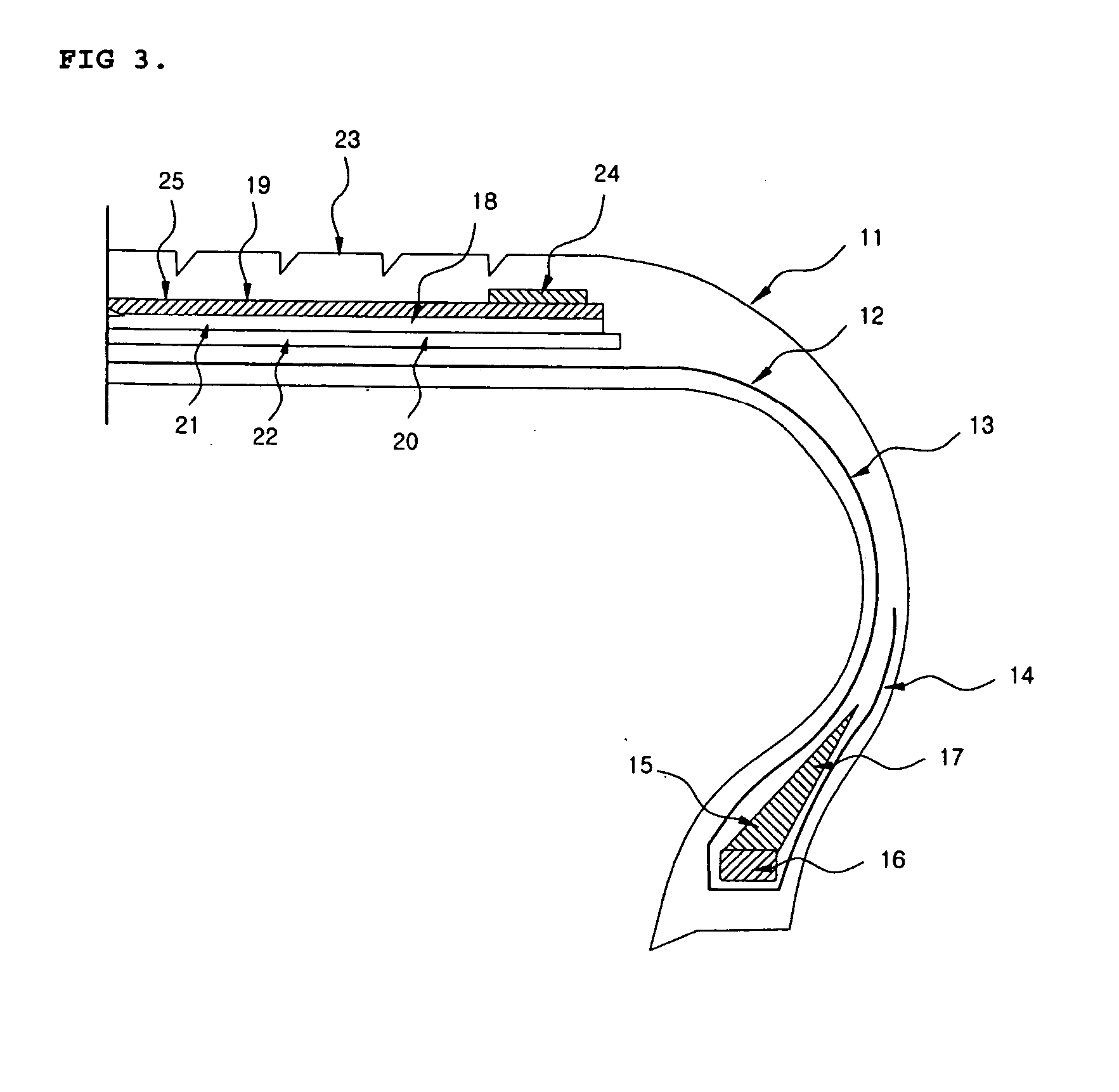Cellulose dip cord produced from highly homogeneous cellulose solution and tire using the same
a technology of cellulose and lyocell, which is applied in the field of tire production using high-tensile lyocell dip cord, can solve the problems of difficult control of moisture and progress upon tire production, difficulty in satisfying the various functions of tire cord, and reduced modulus, so as to reduce energy consumption, improve physical properties of final yarn, and smooth swollen
- Summary
- Abstract
- Description
- Claims
- Application Information
AI Technical Summary
Benefits of technology
Problems solved by technology
Method used
Image
Examples
example 1
A cellulose sheet having a weight average degree of polymerization of 1200 was put in a pulverizer equipped with a 100 mesh size filter to prepare cellulose powder having a diameter of 5000 μm or less, which the cellulose contents in NMMO solution were 0.05 wt %, 0.5 wt %, 1.0 wt %, 1.5 wt %, 2.0 wt %, as shown in Table 1. An antioxidant was dissolved to 0.070 wt % relative to final cellulose.
Each of the NMMO solutions having cellulose dissolved at 0.05 wt %, 0.5 wt %, 1.0 wt %, 1.5 wt %, 2.0 wt % was injected at an injection temperature of 45 to 55° C. to an extruder 4 maintained at an inside temperature of 70 to 80° C. using a gear pump. The cellulose powder was injected to the extruder using a screw type feeder and heated to a temperature of 60 to 80° C. for a residence time of 0.8 minutes in a swelling zone of the extruder so that the cellulose powder was sufficiently swollen with the NMMO solution. Then, the powder was thoroughly dissolved in a dissolution zone of the extrud...
example 2
The filament yarn prepared by adding 1 wt % of cellulose powder to NMMO in Example 1 was twisted with a same twist number for cable twist / ply twist using a direct twisting machine, as shown in Table 2, and dipped in a common RFL solution, followed by a thermal treatment to form a dip cord, which was evaluated for properties.
TABLE 2Example 2SampleB-1B-2B-3B-4B-5B-6Dip cordTwist number(TPM)360 / 400 / 420 / 420450 / 450470 / 470500 / 500cable twist / ply twist360400Construction(Ply)222222Twist constant(R)0.630.710.750.860.870.92strength(kgf)22.521.819.518.518.315.8Elongation at1.71.82.02.22.22.3specific load(%)Shrinkage(%)0.10.20.30.30.30.4E-S1.82.02.32.52.52.7Adhesion(kgf)13.014.815.015.316.016.0Fatigue818283838688resistance(%)
A greige cord was prepared in a double twisted yarn with a same twist number for cable twist / ply twist. As the twist number of the dip cord increased, the strength was decreased and elongation at specific load and fatigue resistance were increased.
example 3
The filament yarn prepared by adding 1 wt % of cellulose powder to NMMO in Example 1 was twisted into a double twisted yarn or a triple twisted yarn with different twist numbers for cable twist and ply twist using a direct twisting machine and dipped in a common RFL solution, followed by a thermal treatment to form a dip cord, which was evaluated for properties.
TABLE 4Example 3SampleD-1D-2D-3D-4D-5D-6D-7D-8Dip cordTwist420 / 420 / 420 / 470 / 320 / 420 / 420 / 420 / number(TPM)320470520420520320470520cable twist / ply twistConstruc-22222333tion(Ply)Twist0.630.710.750.860.870.600.670.71constant(R)Strength(kgf)22.521.119.518.120.830.128.427.7Elongation at1.71.82.02.22.21.82.12.3specificload(%)Shrinkage(%)0.20.20.30.30.40.10.30.3E-S1.92.02.32.52.61.92.42.6Adhesion(kgf)14.014.814.914.313.513.314.515.1Fatigue8588928791878890resistance(%)
When the filament was twisted into a double twisted yarn with different twist numbers for cable twist and ply twist, if the twist number for cable twist was constant a...
PUM
| Property | Measurement | Unit |
|---|---|---|
| temperature | aaaaa | aaaaa |
| aspect ratio | aaaaa | aaaaa |
| temperature | aaaaa | aaaaa |
Abstract
Description
Claims
Application Information
 Login to View More
Login to View More - R&D
- Intellectual Property
- Life Sciences
- Materials
- Tech Scout
- Unparalleled Data Quality
- Higher Quality Content
- 60% Fewer Hallucinations
Browse by: Latest US Patents, China's latest patents, Technical Efficacy Thesaurus, Application Domain, Technology Topic, Popular Technical Reports.
© 2025 PatSnap. All rights reserved.Legal|Privacy policy|Modern Slavery Act Transparency Statement|Sitemap|About US| Contact US: help@patsnap.com



